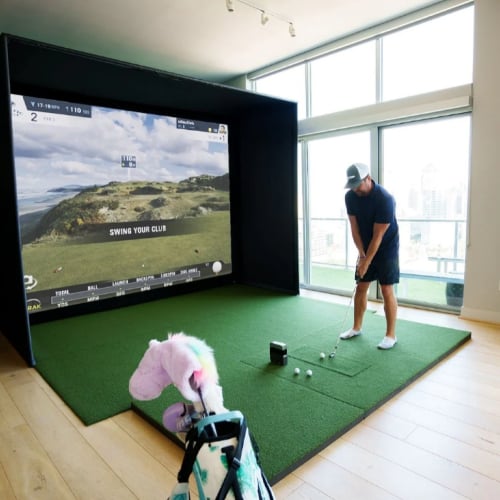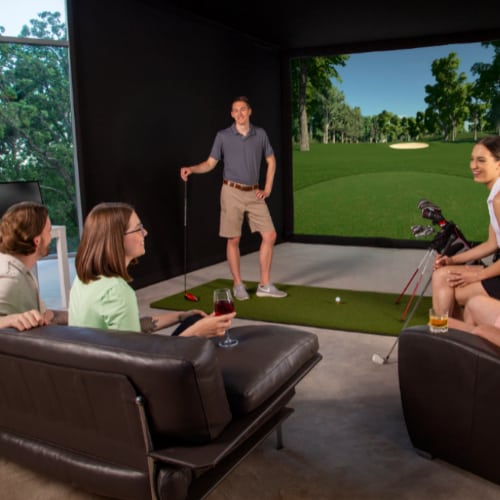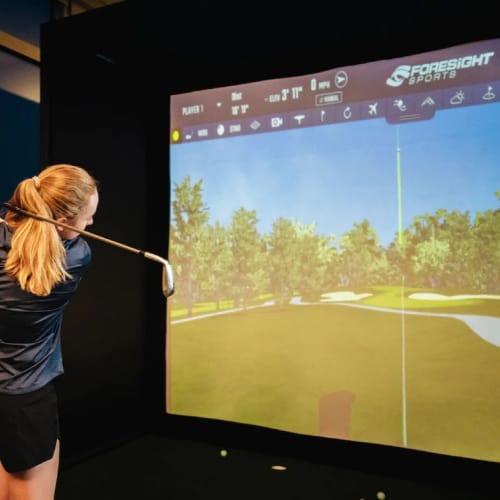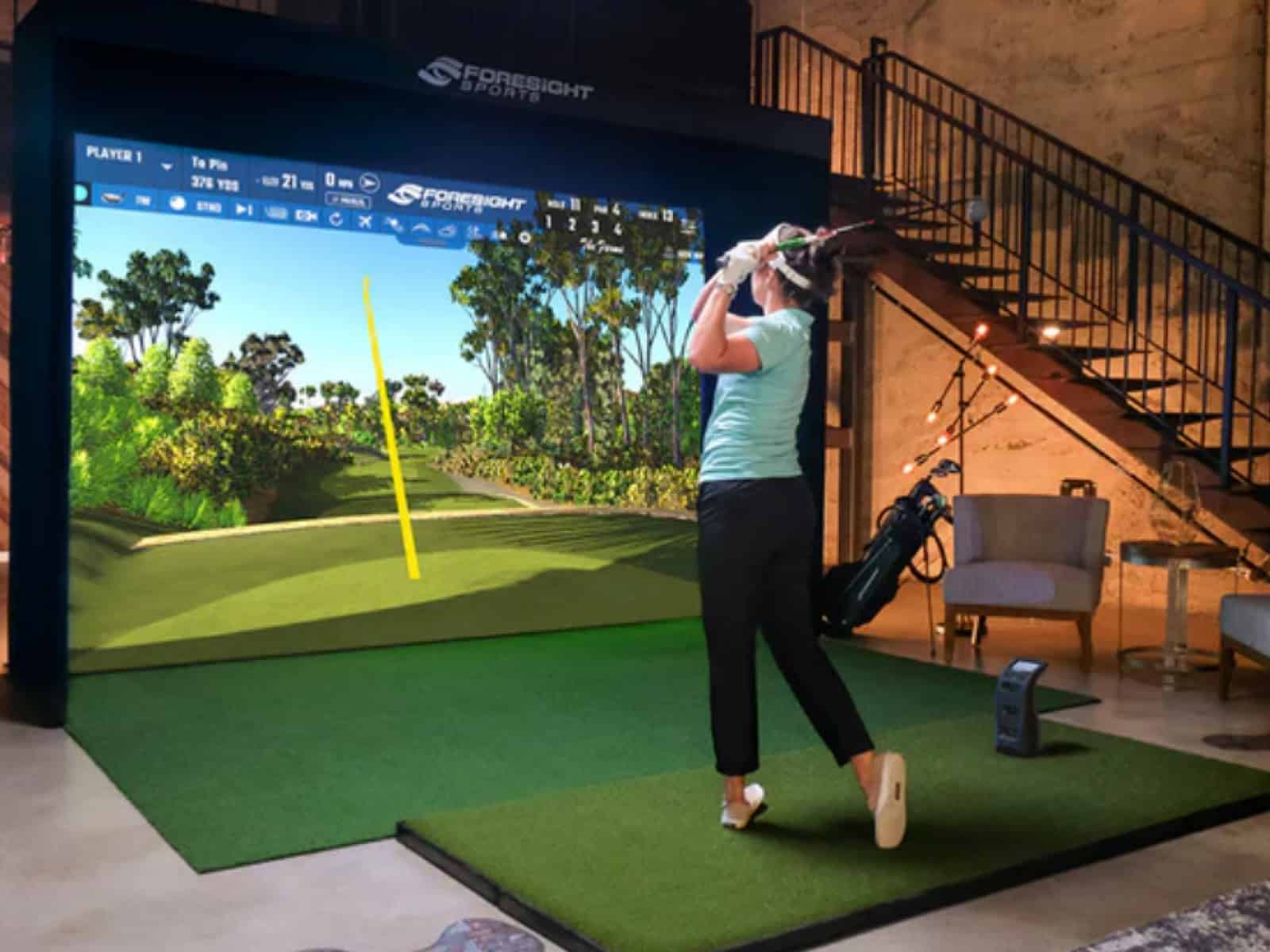Golf simulators let enthusiasts practice and play full rounds indoors, providing a quicker, more convenient golf experience than traditional courses. On a top-quality simulator, experienced solo players can complete 18 holes in much less time than what is usually needed on actual courses.
Simulators feature enclosed bays with advanced technology to recreate an authentic golf outing. Sensors and radar track swing speed, ball data and club metrics to simulate shots on virtual courses shown on a large screen.

In this article, we will explore how much time is needed to complete a full virtual round in different settings and scenarios. We will also help you make the most out of your virtual practice sessions by maximizing the spped of your rounds.
Let’s get started!
Average Time to Play 18 Holes Solo
When playing a solo round on a golf simulator, experienced players can generally complete 18 holes in 45 minutes to an hour. This is a significant time-saver compared to traditional golf, where solo 18-hole rounds take around 4 hours on average.
For seasoned golfers who know their way around a simulator, a speedy 18 holes in under an hour is readily achievable. With no waiting between shots and the ability to proceed right to the next hole, simulators allow for a brisk pace of play.
However, for high handicappers or beginners who are new to golf simulators, a solo 18-hole round may edge over one hour in duration. Factors like unfamiliarity with the simulator equipment, taking time to analyze each shot, and lower skill level can understandably add extra time.
The main advantages of playing solo on a simulator are:
- No waiting on other players’ shots
- Immediately proceeding to the next hole
- Fewer distractions and less chatter
With nobody else in the group, you can play at your own natural pace and rhythm without delays. So for those looking to play quick solo rounds of virtual golf, a simulator is ideal.
Average Time with Friends

While solo rounds on a golf simulator are quite quick, adding more players naturally extends the time taken to complete 18 holes.
When playing with 2 or more friends on a simulator, the average time to finish 18 holes typically exceeds 2 hours. There are several reasons playing in a group slows down the pace:
- Taking turns hitting shots means more down time
- More chatter, banter and analyzing each other’s shots
- Varying skill levels among players
- Taking periodic breaks together
With people socializing, giving each other advice, and watching their playing partners, a group round understandably takes longer than going solo.
Additionally, with more beginner players in the group, the pace of play slows further. Less experienced golfers require more swings and time to complete each hole.
For larger groups of 3 or 4 players, it is not uncommon for 18 holes on a simulator to stretch well over 3 hours. More players means more variables that add time.
The appeal of simulators for many is the social atmosphere with friends. So even though solo rounds are quicker, playing in a group provides fun and camaraderie.
Factors Affecting Time Duration
There are several variables that impact how long it takes to complete 18 holes on a golf simulator. Being aware of these factors can help manage expectations when using a simulator.
Number of Players

As mentioned above, the number of players using the golf simulator directly impacts the pace of play. Solo rounds are the quickest, as there is no waiting between shots and the player can proceed immediately to the next hole after putting out. Rounds with two or more players extend the duration, as each person takes their turn hitting shots.
More players also means more time spent analyzing performance and discussing results between shots. With large groups, the classic pace of play factors like not being ready to hit are intensified, further lengthening the time required.
Skill and Experience Level
A player’s skill and experience level directly affect the pace of their simulator round. Highly skilled golfers with low handicaps can complete 18 holes much faster than beginners. Beginner players require more practice swings and time to set up and hit each shot. Beginners are also less familiar with course management strategies to keep the pace moving.
Additionally, familiarity with the simulator technology and mastery of the virtual courses reduces the time a player takes reading hole layouts and making club selections.
Ultimately, advanced players with golf and simulator proficiency can breeze through 18 holes rapidly, while high handicap beginners will require more time on each hole leading to a slower overall pace.
Simulator Settings
The settings and options chosen on the golf simulator software also impact the pace of play. Enabling “gimme” putts for short distances avoids manual putting on those holes, saving time. An auto-putt setting eliminates all manual putting by automatically sinking putts once on the green, significantly reducing time spent.
More difficult software settings like faster greens, tougher pin placements, and more penal rough increase the number of strokes and penalty shots for many players, lengthening the duration of the round versus easier settings.
Players looking to complete 18 holes rapidly on a simulator should leverage settings like auto-putt and avoid over-challenging conditions that may frustrate and slow down the group. Optimizing the simulator configuration to each player’s skill level and goals enables efficiently moving through the virtual round at the desired pace.
Number of Practice Swings

The number of practice swings on the golf course can influence the pace of play. Experienced golfers often take fewer practice swings to keep the game moving smoothly. In contrast, new players may require more swings to build confidence.
However, excessive practice swings can slow down the game, causing frustration and longer rounds. Striking a balance is key for an enjoyable and efficient round of golf.
Use of Practice Range
The decision to use the virtual practice range for warm-up can impact the duration of your round. Practicing on the virtual range before starting adds time but can help fine-tune your swings.
Still, skipping the range and going straight to the course simulation is quicker and preferred by experienced players who want a faster start.
Your choice depends on how much you value preparation versus pace for an enjoyable virtual round.
Breaks Taken
When players take minimal breaks between shots, they can more easily maintain their rhythm and momentum throughout the round. This fluidity in play contributes to a quicker overall pace and a more enjoyable experience on the course.
On the flip side, frequent or lengthy breaks can significantly slow down the pace of play. These interruptions can disrupt concentration and the flow of the game, resulting in longer rounds and potentially diminishing the overall experience.
That’s why striking a balance between brief, necessary breaks and maintaining a consistent rhythm is key to ensuring a timely and satisfying virtual round.
Benefits of Simulator Speed

Golf simulators offer a distinct advantage over traditional outdoor rounds in terms of speed and convenience, making them an attractive option for many golfers.
One of the most notable benefits is the avoidance of marathon rounds. Traditional 18-hole games can consume upwards of 4 hours, while golf simulators allow players to complete the same 18 holes in under an hour, eliminating the frustration of enduring 5+ hour rounds outdoors.
Additionally, simulator golf offers the convenience of timing. There’s no need to secure tee times; you can play whenever it suits your schedule, making it easier to fit quick rounds into busy lives and maximize limited free time.
The absence of travel between holes is another time-saving factor. You can remain in one simulator bay for the entire round, streamlining the experience. You can also proceed at your own speed without frustrating delays, enhancing the overall enjoyment of the game.
Finally, the accessibility of simulator golf is not constrained by outdoor conditions. Regardless of the weather or time of day, you can enjoy indoor simulator golf year-round. This adaptability allows for morning, afternoon, or evening play in any weather, ensuring you make the most of your golfing opportunities.
Golf simulators offer a compelling alternative for those seeking to play more golf in less time. Their convenience and speed advantages make them an appealing choice compared to traditional golf rounds.
Maximizing Speed on a Simulator
When it comes to maximizing the pace of play on a golf simulator, there are several strategies to help complete 18 holes even more efficiently. While simulator rounds are inherently faster than traditional outdoor golf, adopting certain practices can further enhance the speed of your game.
Firstly, consider using “gimmes” instead of putting out for short putts. By treating putts within a certain range as made, you save valuable time that would otherwise be spent on each hole. Limiting the number of practice swings you take is another way to speed up play. Focusing on 1-2 swings per shot streamlines the process.
Familiarity with the simulator equipment and clubs is crucial for efficient play. New users may need extra time to adjust, but experience leads to a faster rhythm and pace during the round.
Embracing a “ready golf” mentality can also expedite the game. Prepare for your shot while others are hitting, and don’t feel obligated to stick to a strict order, as you might in outdoor golf.
Furthermore, minimizing socializing can contribute to a faster overall time. While some socializing is part of the fun, reducing excessive conversations and distractions helps maintain a swift pace.
All in all, improving the pace of play on a golf simulator involves reducing unnecessary movements and distractions, focusing on efficiency, and embracing practices that make speedy rounds achievable.
Final Thoughts
For anyone with limited time who wants to golf more frequently, simulators are the ideal solution. The technology now provides an authentic virtual golf experience comparable to the real thing. After an initial adjustment period, the quicker pace soon feels natural.
Golf simulators offer a much faster way to play 18 holes compared to traditional golf. For experienced players playing solo rounds, completing 18 holes in under an hour is readily achievable.
With friends, gameplay takes longer due to social factors, but still remains significantly quicker than 4+ hour rounds on normal courses. The pace of play is affected by the number of players, skill levels, simulator settings, practice swings and breaks taken.
In this article, we explored the topic in detail, and tried to provide tips to help you maximize your time spent in the virtual golf world. If you have any questions or comments, feel free to contact us through the comments section or via email.
Thanks for reading!





